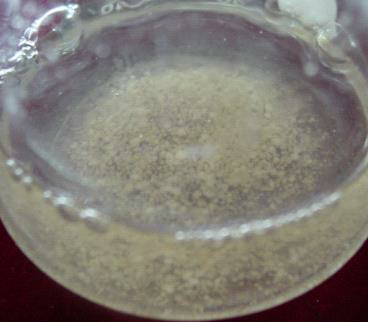

收稿日期: 2019-08-27
录用日期: 2019-11-13
网络出版日期: 2019-11-14
基金资助
国家中医药行业科研专项子课题(201407005-08);河南省创新型科技人才队伍建设工程(C20130037);河南省高等学校青年骨干教师培养计划(2018GGJS293)
Optimization of Cell Suspension Culture Conditions of Achyranthes bidentata
Received date: 2019-08-27
Accepted date: 2019-11-13
Online published: 2019-11-14
李萍 , 董亚辉 , 李成龙 , 何雨龙 , 李明军 . 怀牛膝细胞悬浮培养条件的优化[J]. 植物学报, 2020 , 55(1) : 90 -95 . DOI: 10.11983/CBB19168
To optimize the suspension culture conditions of Achyranthes bidentata cells, effect of different factors like inoculum concentrations, subculture cycles, pH, light and Cu 2+ on cell growth and polysaccharides contents was studied. The results showed that, cells grew well with a good ability for polysaccharides synthesis under 50 g·L -1 inoculum concentration, 14 d subculture cycle, pH5-6 and light. In the presence of 50 μmol·L -1 Cu 2+, the cell dry weight could be the maximum with 44.63 g·L -1, and polysaccharides contents reached the peak at 4.02 mg·g -1.

| [1] | 别振宇, 李兴林, 汪珊英 (2017) . 诱导子对蜀葵悬浮细胞、不定根培养的影响. 天津科技大学学报 32(3), 23-28. |
| [2] | 陈月华, 朱艳, 张翔, 秦民坚 (2016). 植物细胞悬浮培养中次生代谢产物积累的研究进展. 中国野生植物资源 35(3), 41-47, 57. |
| [3] | 范美华, 刘树楠, 张国彬, 周吉源 (2004). 半夏细胞悬浮培养中生理生化指标的测定. 生物技术 14(5), 78-81. |
| [4] | 付国辉, 陈随清, 刘嘉, 马蕊, 杨国静, 杨慧辛 (2018). 牛膝化学成分及等级分类研究. 海峡药学 30(2), 29-32. |
| [5] | 郭丹丹, 刘飞, 涂燕华, 高越, 郭美丽 (2016). 红花悬浮细胞体系的建立及其化学成分的UPLC-Q-TOF/MS分析. 中草药 47, 4439-4444. |
| [6] | 国家药典委员会 (2015). 中华人民共和国药典. 北京: 中国医药科技出版社. pp. 38. |
| [7] | 胡婷婷, 张振凌 (2016). 中药牛膝化学成分、药理作用及储藏保管. 中国老年学杂志 36, 3321-3322. |
| [8] | 李家儒, 管志勇, 刘曼西, 吴振斌, 王君健 (1999). Cu2+对红豆杉培养细胞中紫杉醇形成的影响. 华中农业大学学报 18, 117-120. |
| [9] | 李明军, 李萍, 赵喜亭, 张晓丽, 周娜, 王凤娟 (2008). 怀牛膝细胞悬浮培养及多糖含量变化的研究. 西北植物学报 28, 494-500. |
| [10] | 李萍, 许言, 张晓丽, 李炯, 赵喜亭, 李明军 (2017). 不同诱导子对怀牛膝细胞生长及多糖含量的影响. 植物学报 52, 615-621. |
| [11] | 李萍, 赵喜亭, 李明军, 周彩云 (2015). 怀牛膝悬浮培养细胞生理生化特性研究. 河南农业科学 44, 106-110. |
| [12] | 李铁军, 廉美兰, 于丹, 邵春绘, 朴炫春 (2013). 几种因素对悬浮培养人参细胞生长和皂苷积累的影响. 中国中药杂志 38, 4047-4051. |
| [13] | 廖斌, 李汉生, 徐小萍, 董浩, 吴宇函, 梁梓豪, 李珊珊, 屈蒙蒙, 林玉玲, 赖钟雄 (2019). 不同光照条件对龙眼胚性悬浮细胞培养及柯里拉京合成的影响. 福建农业学报 34, 27-34. |
| [14] | 栾林莉, 宋玉凤, 侯辛辛, 陈健妙 (2019). 巴西橡胶树体胚胚性愈伤组织悬浮系的建立和植株再生. 分子植物育种 17, 2614-2621. |
| [15] | 罗红梅 (2003). 莪术细胞悬浮培养, 挥发油、多糖分离及其多糖生物学活性研究. 硕士论文. 大连: 辽宁师范大学. pp. 20-21. |
| [16] | 孟婷, 陈随清 (2017). 冬凌草细胞悬浮培养技术研究. 河南中医 37, 1107-1110. |
| [17] | 石若夫 (2002). 栀子组织和悬浮细胞培养及其多糖的分离纯化和生物学活性的研究. 博士论文. 大连: 大连理工大学. pp. 57-58. |
| [18] | 王娟, 李金鑫, 李建丽, 高文远 (2017). 植物组织培养技术在中药资源中的应用. 中国中药杂志 42, 2236-2246. |
| [19] | 王一惠, 孙睿, 宋萍, 封磊, 吴承祯, 洪伟, 宋欢 (2018). 内生细菌及其组合对雷公藤悬浮细胞生长及生化特性的影响. 热带作物学报 39, 1947-1954. |
| [20] | 王争艳, 王霞, 王欢 (2017). 玉竹愈伤组织诱导及其细胞悬浮培养体系的建立. 福建农业学报 32, 963-968. |
| [21] | 吴燕燕, 李明, 马婷玉, 段修冉, 潘丽萍 (2018). 白木香悬浮细胞培养的研究. 中药材 41, 1044-1047. |
| [22] | 徐志荣, 王婷, 娄佳兰, 魏赛金 (2019). 南方红豆杉细胞悬浮培养体系优化及动力学研究. 林业科学研究 31(21), 8-14. |
| [23] | 张纯, 郭文彪, 王雯佶, 陈爱华, 郭澄 (2003). 改良硫酸蒽酮比色法测定牛膝多糖的含量. 中华临床医药 4(19), 17-18. |
| [24] | 赵爽, 刘颖, 王加利, 袁将, 姬瑞芳, 全庆华, 王贝贝, 董洁, 冀娇娇, 刘永刚 (2017). 利用植物悬浮细胞体系对骆驼蓬碱进行生物转化. 中医学报 32, 103-105, 123. |
| [25] | 周春江, 李卫东, 葛会波 (2002). 草莓悬浮细胞系的建立及某些影响因素. 植物生理学通讯 38, 22-24. |
| [26] | 祖恩凡, 赵晨晨, 张凌霄, 钱晶晶 (2019). 金银花细胞悬浮培养体系的建立研究. 现代园艺 ( 6), 5-6. |
| [27] | Gaisser S, Heide L (1996). Inhibition and regulation of shikonin biosynthesis in suspension cultures of Lithospermum. Phytochemistry 41, 1065-1072. |
| [28] | Harashima H, Kato K, Shinmyo A, Sekine M (2007). Auxin is required for the assembly of A-type cyclin-dependent kinase complexes in tobacco cell suspension culture. J Plant Physiol 164, 1103-1112. |
| [29] | Huntley RP, Murray JAH (1999). The plant cell cycle. Curr Opin Plant Biol 2, 440-444. |
| [30] | Morimoto T, Hara Y, Kato Y, Hiratsuka J, Yoshioka T, Fujita Y, Yamada Y (1989). Berberine production by cultured Coptis japonica cells in a one-stage culture using medium with a high copper concentration. Agric Biol Chem 52, 1835-1836. |
| [31] | Ozeki Y, Komamine A (1985). Effects of inoculum density, zeatin and sucrose on anthocyanin accumulation in a carrot suspension culture. Plant Cell Tissue Organ Cult 5, 45-53. |
| [32] | Pestchanker LJ, Roberts SC, Shuler ML (1996). Kinetics of taxol production and nutrient use in suspension cultures of Taxus cuspidata in shake flasks and a Wilson-type bioreactor. Enzyme Microb Technol 19, 256-260. |
| [33] | Rijhwani SK, Shanks JV (1998). Effect of subculture cycle on growth and indole alkaloid production by Catharanthus roseus hairy root cultures. Enzyme Microb Technol 22, 606-611. |
| [34] | Rouxel T, Kollmann A, Boulidard L, Mithen R (1991). Abiotic elicitation of indole phytoalexins and resistance to Leptosphaeria maculans within Brassiceae. Planta 184, 271-278. |
| [35] | Santarem ER, Pelissier B, Finer JJ (1997). Effect of explant orientation, pH, solidifying agent and wounding on initiation of soybean somatic embryos. In Vitro Cell Dev Biol Plant 33, 13-19. |
| [36] | Zhang YH, Zhong JJ (1997). Hyperproduction of ginseng saponin and polysaccharide by high density cultivation of Panax notoginseng cells. Enzyme Microb Technol 21, 59-63. |
| [37] | Zhong JJ, Wang DJ (1996). Improvement of cell growth and production of ginseng saponin and polysaccharide in suspension cultures of Panax notoginseng: Cu2+ effect. J Biotechnol 46, 69-72. |
/
| 〈 |
|
〉 |